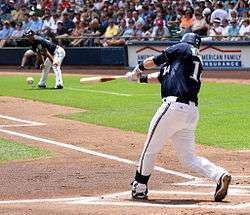Batted ball
In the sports of baseball and softball, a batted ball is a pitch that has been contacted by the batter's bat. Depending on where the ball lands, a batted ball can become either a fair ball or a foul ball. If a batted ball is a fair ball, fielders attempt to get the batter out. A foul ball is assessed as a strike unless the batter has already accumulated two strikes, in which case the number of strikes does not increase (with the exception of a foul bunt or foul tip). Batted balls are also classified by their trajectory. The most common of these trajectory-based classifications are fly balls, line drives, and ground balls.

Classification
By result
Fair or foul
On the baseball field, a straight line (officially known as a foul line) is drawn from each front corner of home plate past either first base or third base (the left line past third base and the right line past first base) all the way to the far end of the outfield. Balls that land between or on the foul lines are considered to be fair, and fielders can attempt to make an out from those balls, but balls landing outside the lines are considered to be foul.[1] A foul ball counts as a strike unless the batter already has had two strikes assessed against them (with the sole exception of foul bunts, which are described below).[2] A foul ball can also be caught for an out before it hits the ground.[1]
Foul tip
By official rule, a foul tip is a type of batted ball that occurs when the batter makes contact with the pitch, but not enough to change the path of the ball. Additionally, the catcher must catch the ball without dropping it.[3] A foul tip, if caught according to the requirements, is considered to be the same as a regular strike, so a foul tip with two strikes already in the count results in a strikeout.[3]
By trajectory
Fly ball
A fly ball is a batted ball hit in an arcing manner.[4] Fielders attempt to catch fly balls on their descent, and an out is recorded if the ball is caught before it hits the ground.[5]
A specific rule applies to fielders attempting to catch some fly balls: the infield fly rule. If a fly ball is hit with a high trajectory, but does not travel much straight-line distance, (a type of fly ball generally known as a pop fly or pop up) and baserunners are on first base and second base (or if all three bases are occupied), the batter is called out, regardless if the fielder catches the ball. This rule is in place to prevent fielders from intentionally dropping the ball in order to create a force play and the opportunity to get multiples outs on the play.[6] The infield fly rule does apply if the batted ball is a foul ball.[4]
Line drive
A line drive is a batted ball hit into the air that travels with a relatively flat trajectory ("on a line").[7] Batters generally have a higher batting average on line drives, as line drives are typically hit harder than fly balls or ground balls and the flatter trajectory makes them harder to catch.[8] These same tendencies also make line drives dangerous. In 2007, first base coach Mike Coolbaugh was killed when a line drive hit him in the head during a minor league game.[9] In 2019, a fan at a Houston Astros game required hospitalization after being hit with a foul line drive.[10]
Ground ball
A ground ball (or grounder) is a batted ball that is hit at a low enough trajectory that it hits the ground a short distance after being hit and then rolls or bounces on the ground.[4] In some situations dependent on which bases are occupied by runners, a ground ball can result in a double play, often via a force out.[11] Ground balls are distinct from line drives and fly balls that hit the ground and bounce afterwards; the distinction is that ground balls are hit towards the ground, while fly balls and line drives are hit away from the ground and only hit the ground as an end result.[12]
Bunt
A bunt is a special type of batted ball. Bunts are distinct from other types of batted balls because bunts occur when pitched balls are "intentionally met with the bat," not swung at.[4] Unlike other types of batted balls, for which a third strike is not assessed when a foul ball is hit with two strikes in the count, a third strike is assessed to the batter when a two-strike bunt goes foul, resulting in a strikeout. This rule originated as an attempt to stymie the attempts of batters to intentionally bunt pitches foul in order to tire the pitcher.[13]
References
- "Foul line". baseball-reference.com. Retrieved 7 February 2020.
- "Foul Strike Rule". baseball-reference.com. Retrieved 7 February 2020.
- "What is a Foul Tip?". Major League Baseball. Retrieved 7 February 2020.
- "Definition of Terms" (PDF). Major League Baseball. Retrieved 6 February 2020.
- "What is a Flyout". Major League Baseball. Retrieved 6 February 2020.
- "In Defense of Baseball's Infield Fly Rule". The Atlantic. 12 October 2012. Retrieved 6 February 2020.
- "Line Drive". baseball-reference.com. Retrieved 6 February 2020.
- James, Bill. "What I Have Learned About Fly Balls and Such". billjamesonline.com. Retrieved 6 February 2020.
- "Coolbaugh, 35, Dies After Being Struck by Ball". ESPN. 23 July 2007. Retrieved 6 February 2020.
- Rieken, Kristie (30 May 2019). "Child Hit by Line Drive at Astros Game, Taken to Hospital". Associated Press. Retrieved 6 February 2020.
- "Ground Into Double Play (GIDP)". Major League Baseball. Retrieved 6 February 2020.
- "Ground Ball". baseball-reference.com. Retrieved 6 February 2020.
- Snyder, Matt. "History of Two-Strike Bunt Rule a Reminder Pace of Play Issues are Over a Century Old". CBS Sports. Retrieved 6 February 2020.